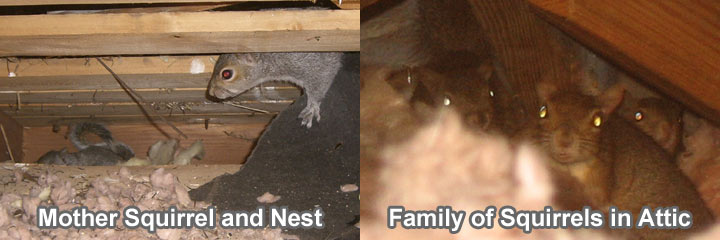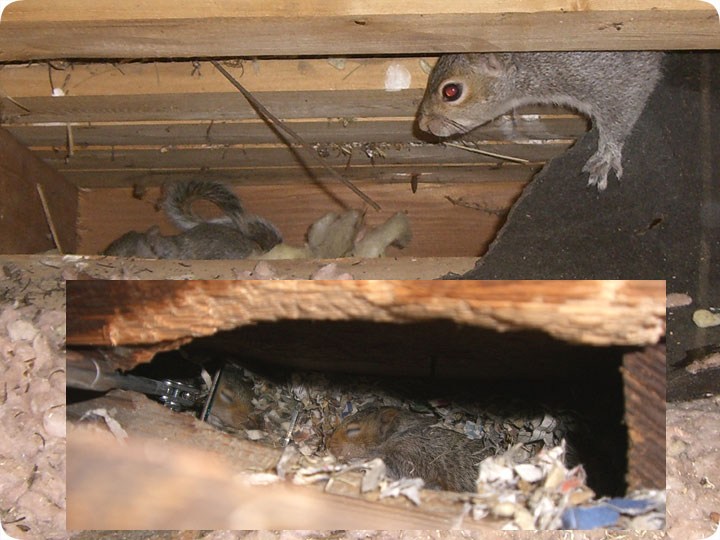The most common animal in the USA that lives in the attic is the Eastern Gray Squirrel. These animals are diurnal - that means they are active in the daytime. In fact,
they are most active during the early morning and evening hours. If you hear noises in the attic during the day, it's very likely from squirrels. The sounds from
squirrels in the house include scurrying sounds, from them running around on the drywall in the attic, above the ceiling, or in the walls. You may also hear some
scratching sounds, or even some nuts rolling around. Squirrels don't usually make vocal sounds inside the attic.

NEED LOCAL HELP? We are wildlife removal professionals servicing 95% of the USA. Click here to
hire our local squirrel removal expert in your home town. Updated 2021. But read the below advice first!
If you hear sounds during the night, they are most likely made by a nocturnal animal, such as a raccoon, opossum, rat, mouse, or flying squirrels. While it's true that
many more species of animal in the attic are nocturnal, it's also true that squirrels are the single most common invader of attics. Anyway, when it comes to sounds in
the attic from animals, you're in luck, at least in terms of identifying the animal, if you hear the noises during daylight hours, because that almost surely means it's a squirrel.
Can a squirrel make noises at night? Yes, possibly. Most diurnal animals wake a few times a night, and might move around - the same goes for people - but if you hear the noises
at night, then it's unlikely a squirrel, and very likely on of the nocturnal animals like rats or raccoons. Read more here: are squirrels ever active at night?
NOTE: I have received so many requests for professional help with catching squirrels, that I have made this complete listing of hundreds of (link ->)
professional squirrel removal experts who I trust, serving every city in the USA.

Scratching sounds in the attics or walls - Scratching sound in the attic or walls is an indication that your premise has been invaded by a wild animal. The commonest types of animals that invade the attics and walls are squirrels, rats, and mice. These animals are quite small to the extent that they can crawl through homes less than 2cm, or less for mice. identifying the animals in the attic or walls is very important to determining what type of methods to use in getting rid of them.
Noises in the roofs and lofts may be cause by birds, rats, mice or squirrels. Most bird will prefer to create their nests on flat areas of the roof, and then you may notice some moss and grass dropping from the roof. Windowsills may also be used by some other types of birds , where they build nests with feathers, grasses and plant stems. For rats that invade the roof, you will likely notice their droppings along the way they move. Birds particularly make noise in the attic in the morning or afternoon when they are most active, and they often make some squeaky noises while using their beaks to hit the top of the roof. Birds are hardly found in walls; therefore, you must concentrate your search main on the roof and exterior parts such as window ledges.
Daytime noises are often caused by squirrels, and they are some of the commonest animals you can find in attics, lofts, walls, eaves and soffits. Squirrel noises are characterized by daytime noises, particularly from early in the morning till early in the evening. Fast and scurrying noises in day time are mostly caused by squirrels, though raccoons also make noises in daytime also but their noises are usually slower and heavier than those caused by squirrels.
Vocal noises are mostly caused by raccoons in the attic. The invasion of the attic by bats , can be recognized by scurrying high-pitch noises . Bats in the attic may also create some chirping and high pitch noises. Raccoons don't sleep for long, and can make noises all day long. Baby raccoons can make some vocal racket noises, therefore, if you hear such noises in your attic, you should suspect raccoons first.
Pitter-patter noises that are very fast at night may signify the presence of rats or mice in the attic. Rats and mice can make quick scratching sounds at the door, wall or close to the windows, and even beside your bed. Depending on the acoustics nature of the house, rats and mice can make loud noises that can wake you up from sleep and they can make scratching noises as they run from one point to the other. The noise of rats and mice often goes up and down, and the larger the animal the heavier the noises.
Thumping noises at night is a sign that a larger animal is within your attic and most especially raccoons and Possums. Smaller animals such as mice and rats will sleekly move under the insulators of the attics, or down the soffits before moving out of the attic, when they suspect human movements around. In most cases, you should be able to identify the smell or scent of the droppings left behind in the attic, wall vent or anywhere else and you should try to follow such droppings along its tracks to ascertain where the animals has been using to gain entrance.
The presence of a snake in the attic can be recognized by a slow slithering sound and that means you must take immediate action by paying attention to where the slithering sound is emanating from. It can be difficult sometimes to ascertain where slithering snake sounds are from but the best thing to do is to create some agitation by hitting a rod on certain components just to frighten the animal.
Trapping is the best possible way to capture animals that are active in the attic, wall or any other part of your home, this however should be the last step you should carry out. First of all, you need to carry out some structural repairs to the holes, cracks and other avenues used by animals to access your attic, wall and other areas. Secondly, you need to remove all droppings and leftover by the animal, then you need to disinfect the area to ensure that residues of the droppings are not left as such can cause allergic reactions or some other infections to humans and pets. Make sure all external areas such as yards, patios, and decks are checked to ensure that wild animals do not use such areas to hide and access the internal area of the house.
Make sure that the roof, and ceilings are properly inspected to ascertain which area need proper repairs. Holes in the roof are very attractive to squirrels. Read about What attracts squirrels? In most cases, the droppings of rats and mice can cause heavy pressure on the ceiling thus pushing the ceiling down until it caves in. you need to check the chimney and see if the cap has been damaged or removed therefore it must be replaced immediately. Broken or unavailable caps on chimneys is one of the major reason why animals such as birds and bats have access to roofs and internal area of the home.
Go back to the Squirrels in the Attic home page.
NEED SQUIRREL REMOVAL HELP? We service over 150 USA cities. click gere to hire us in your home town. Updated 2021.